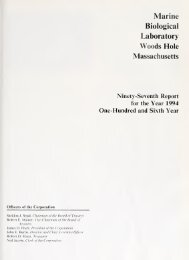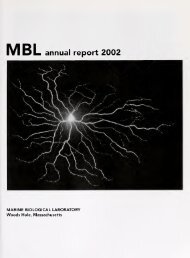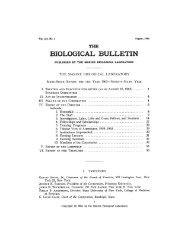22 researchThe High Cost of Coastal LivingUnderstanding West Falmouth Harbor’s Responseto Nitrogen PollutionThe beautiful beaches and harbors of Cape Cod seem to encourage more developmentand more residents each year. MBL Ecosystems Center scientists have found the perfectlaboratory for studying just how costly this popularity may be for the local environment:West Falmouth HarborFor 17 years, the Town of Falmouth’s main wastewater treatment facility has operated inthe West Falmouth Harbor watershed. Nitrogen inputs to the harbor have increased twofoldover the last few years and are expected to increase further over the next three to five yearsas a plume of nitrogen-contaminated groundwater originating from Falmouth’s wastewatertreatment plant reaches the estuary. Wastewater transported through groundwater toestuaries is a major supplier of nitrogen in densely populated watersheds, and contributesto coastal eutrophication, a condition that can cause suffocating algae growth and death ofanimal life from lack of oxygen.To assess the response of West Falmouth Harbor to rapid increases in nitrogen pollution,MBL Ecosystems Center scientists Anne Giblin, Kenneth Foreman, and Jane Tucker, andtheir colleagues from Cornell <strong>University</strong> and the <strong>University</strong> of Virginia, are studying themechanisms behind changes in the West Falmouth Harbor ecosystem during differentstages of nitrogen enrichment. The project is funded by a major National ScienceFoundation biocomplexity grant. The whole-ecosystem “experiment” mimics the transitionfrom low to moderate, and ultimately to high, nutrient loading within the ecosystem.“Because the nitrogen inputs [coming from the treatment plant] are well documented, WestFalmouth serves as a model system to study how internal nitrogen processing is altered byincreasing nitrogen pollution,” says GiblinThe scientists working on the study hypothesize that West Falmouth Harbor will respondto nitrogen pollution in phases. As wastewater inputs of nitrogen begin to increase,they expect that nitrogen fixation—the process by which bacteria convert nitrogen gasfrom the air into forms that can be used by plants and animals—will be reduced. But atthe same time, the loss of nitrogen from the system through another bacterial process(denitrification) may increase. As a result, during the early stages of nitrogen pollution inWest Falmouth Harbor, plants and animals within the ecosystems may show only a modestresponse to the contaminated groundwater generated by the plume. “In West Falmouththere has been some eel grass loss but there are large areas of the harbor where eel grassremains,” says Giblin.
esearch 23Ecosystems Center staff, continuedBut as nitrogen inputs increase over time, the bacterial processes that helpreduce reactive nitrogen levels will decrease. Scientists believe that thiswill lead to a second phase of eutrophication with fairly rapid changes inplant and animal communities. For example, sea grass beds may disappearand be replaced by large mats of algae. Finally, as nitrogen inputs increasefurther, algal mats could be replaced by dense phytoplankton blooms.“With these changes in the types and productivity of plants we may seelarge decreases in the oxygen content in the water, at night, or on calmcloudy days, which could upset the delicate balance of this ecosystem,”Giblin says. “We have seen these changes in many of our other coastalponds already.”“West Falmouth Harbor serves as anoutdoor classroom of sorts during theSES. This allows undergraduate studentsto get hands-on experience in ecosystemsscience and helps us gather long-termdata on nitrogen inputs to the harbor.— SES Program Director Kenneth ForemanWhat is the future of West FalmouthHarbor? “Fortunately, because theFalmouth Wastewater Treatmentplant is implementing advancedwastewater treatment, nitrogen loadsto the harbor will begin decreasingwithin the next decade when cleanergroundwater reaches the coast,” saysGiblin. “However, we do not knowfor sure how long it would take theharbor to bounce back and whetheror not, once lost, eelgrass beds willreturn.“Besides being a good model system for the study of nitrogen pollution,West Falmouth Harbor provides a perfect opportunity for students in theCenter’s Semester in Environmental Science (SES) to become involved incurrent research. “West Falmouth Harbor serves as an outdoor classroomof sorts during the SES,” notes Foreman, SES Program Director. “This allowsundergraduate students to get hands-on experience in ecosystems scienceand helps us gather long-term data on nitrogen inputs to the harbor.”Vinton J. ValentineYuriko YanoQianlai ZhuangTECHNICAL STAFFMichele P. Bahr, Senior Research AssistantJoseph H. Blanchard, Research AssistantAllison E. Burce, Teaching AssistantDonald W. Burnette, Research AssistantChristopher P. Crockett, Research AssistantClara Funk, Research AssistantEmily F. Gaines, Research AssistantRobert H. Garritt, Senior Research AssistantAdrian C. Green, Research AssistantChristie L. Haupert, Research AssistantShaomin Hu, Research AssistantSuilou Huang, Research AssistantJ. Michael Johnson, Research AssistantBrooke Kaye, Research AssistantSamuel Kelsey, Research AssistantBonnie L. Kwiatkowski, Research AssistantJames A. Laundre, Senior Research AssistantWilliam M. Lee, Research AssistantRichard P. McHorney, Senior Research AssistantMarshall L. Otter, Senior Research AssistantChristian R. Picard, Research AssistantCarol Schwamb, Laboratory AssistantLorna Street, Research AssistantSuzanne M. Thomas, Research AssistantJane Tucker, Senior Research AssistantIan J. Washbourne, Research AssistantJ.C. Weber, Senior Research AssistantHeidi S. Wilcox, Research AssistantLaura E. Wittman, Research AssistantADJUNCT SCIENTISTSPaul Colinvaux, Smithsonian Tropical Research CenterMaureen Conte, Bermuda Biological Station forResearch, Inc.Robert Howarth, Cornell <strong>University</strong>VISITING SCHOLARSNeil Bettez, Cornell <strong>University</strong>Maíra Ometto Bezerra, <strong>University</strong> of São PauloHoward Drossman, Colorado CollegeJames Galloway, <strong>University</strong> of VirginiaKetil Koop-Jakobsen, Boston <strong>University</strong> Marine ProgramKarin Rebel, Georgia Institute of TechnologyADMINISTRATIVE STAFFDorothy J. Berthel, Administrative AssistantSuzanne J. Donovan, Graphics and Website SpecialistKelly R. Holzworth, Center AdministratorDeborah G. Scanlon, Projects and Publications CoordinatorMary Ann Seifert, Administrative AssistantBROWN-MBL Graduate StudentsMarselle Alexander-OzinskasGillian GalfordSeeta SistlaCONSULTANTFrancis P. Bowles, Research Systems Consultant
- Page 1 and 2: MBL7 MBL StreetNon-profit Org.U.S.
- Page 5: contents1 report of the director an
- Page 8 and 9: 2 report of the director and ceoTha
- Page 10 and 11: 4 program profiles“Our lives are
- Page 12 and 13: 6 program profilesoffering unmatche
- Page 14 and 15: 8 program profilestraining pre and
- Page 16 and 17: 10 program profilesforging powerful
- Page 18 and 19: 12 program profilesengaging undergr
- Page 20 and 21: 14 program profilesexciting k-12 te
- Page 22 and 23: 16 researchresearchThe MBL is one o
- Page 24 and 25: 18 researchgenomes. The National Ae
- Page 26 and 27: 20 researchPublicationsAmaral Zettl
- Page 30 and 31: 24 researchJohn Hobbie Named MBL Di
- Page 32 and 33: 26 researchwhitman centerThe Whitma
- Page 34 and 35: 28 researchA New Twist on Power Wal
- Page 36 and 37: 30 researchfellowshipsMBL Research
- Page 38 and 39: 32 researchAlbert and Ellen Grass F
- Page 40 and 41: 34 researchFriday Evening Lecture S
- Page 42 and 43: 36 researcharchitectural dynamics i
- Page 44 and 45: 38 researchBUMP staff, cont.PH.D. S
- Page 46 and 47: 40 researchmarine resources program
- Page 48 and 49: 42 researchMarine Resources Program
- Page 50 and 51: 44 researchprogram in molecular phy
- Page 52 and 53: 46 researchlaboratory of aquatic bi
- Page 54 and 55: 48 researchlaboratory of norman wai
- Page 56 and 57: 50 educationsummer coursesBiology o
- Page 58 and 59: 52 educationGreenberg, Everett, Uni
- Page 60 and 61: 54 educationMaul, Kristen, City Col
- Page 62 and 63: 56 educationPata, Veena, National I
- Page 64 and 65: 58 educationspecial topics coursesA
- Page 66 and 67: 60 educationMaiato, Helder, Institu
- Page 68 and 69: 62 educationBrower, Stewart, Univer
- Page 70 and 71: 64 educationFACULTYCurran, Sean, Ma
- Page 72 and 73: 66 educationGeunes-Boyer, Scarlett,
- Page 74 and 75: 68 educationSTUDENTSAparicio, Paul,
- Page 76 and 77: 70 educationother educational progr
- Page 78 and 79:
72 educationscholarship awardsIn 20
- Page 80 and 81:
74 educationCaswell Grave Scholarsh
- Page 82 and 83:
76 educationMilton L. Shifman Endow
- Page 84 and 85:
78 mblwhoi librarytrends, and curre
- Page 86 and 87:
80 financialsfinancialsreport of th
- Page 88 and 89:
82 financialsOperating History and
- Page 90 and 91:
84 giftsWe are grateful as well to
- Page 92 and 93:
86 giftsRestricted gifts(up to $9,9
- Page 94 and 95:
88 giftsMEMBER($1,000 - $2,499)Edwa
- Page 96 and 97:
90 giftsJohn E. Hobbie Fund for Sci
- Page 98 and 99:
92 giftsMr. and Mrs. J. Sterling Cr
- Page 100 and 101:
94 giftsLectureshipsJohn J. Cebra L
- Page 102 and 103:
96 gifts10th AnniversaryDr. Eva M.
- Page 104 and 105:
98 giftsMBL AssociatesThe Associate
- Page 106 and 107:
100 giftsMr. James K. TaylorMrs. Al
- Page 108 and 109:
102 giftsMBL Golf OutingIn July, MB
- Page 110 and 111:
104 giftsFellowships Established in
- Page 112 and 113:
106 giftsSemester in Environmental
- Page 114 and 115:
108 governance & administrationgove
- Page 116 and 117:
110 governance & administrationcorp
- Page 118 and 119:
112 governance & administrationDr.
- Page 120 and 121:
114 governance & administrationcoun
- Page 122 and 123:
116 governance & administrationadmi
- Page 124:
118 governance & administrationPhot
















